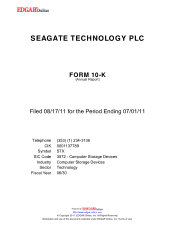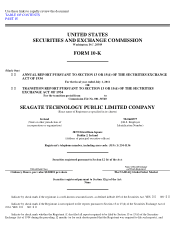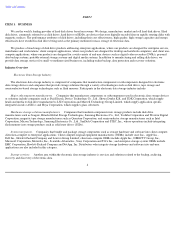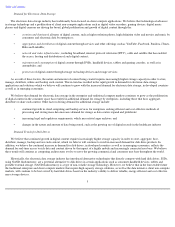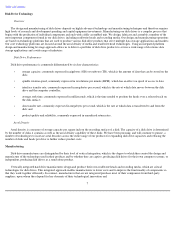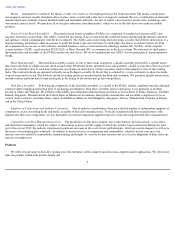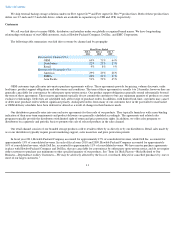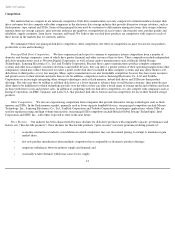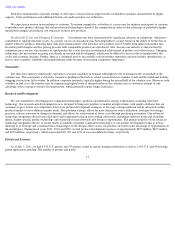Seagate 2010 Annual Report Download - page 9
Download and view the complete annual report
Please find page 9 of the 2010 Seagate annual report below. You can navigate through the pages in the report by either clicking on the pages listed below, or by using the keyword search tool below to find specific information within the annual report.
Table of Contents
Disk Drives for Enterprise Storage. We define enterprise storage as disk drives designed for mission critical applications and nearline
applications.
Mission critical applications are defined as applications that are vital to the operation of enterprises, requiring high performance, and high
reliability disk drives. We expect the market for mission critical enterprise storage solutions to continue to be driven by enterprises moving
network traffic to dedicated storage area networks in an effort to reduce network complexity and increase energy savings. We believe that this
transition will lead to an increased demand for more energy efficient, smaller form factor disk drives. These solutions are comprised principally
of high performance enterprise class disk drives with sophisticated firmware and communications technologies.
Nearline applications are defined as applications that are capacity-intensive and require high capacity and energy efficient disk drives
featuring low costs per gigabyte. We expect such applications, which include storage for cloud computing and backup services, will continue to
grow and drive demand for disk drives designed with these attributes.
SSD storage applications have been introduced as a potential alternative to redundant system startup or boot disk drives. In addition,
enterprises are gradually adopting SSDs in applications where rapid processing and/or energy efficiency is required. The timing of significant
adoption of SSDs is dependent on enterprises weighing the cost effectiveness and other benefits of mission critical enterprise disk drives against
the perceived performance benefits of SSDs.
Disk Drives for Client Compute. We define client compute applications as disk drives designed for the traditional desktop and mobile
compute applications. We believe that the increase in demand resulting from growing economies of certain countries and the continued
proliferation of digital content will drive the demand for the client compute market.
Disk Drives for Client Non-Compute. We define client non-compute applications as disk drives designed for consumer electronic devices
and disk drives used for external storage and network-attached storage (NAS). Disk drives designed for consumer electronic devices are
primarily used in applications such as DVRs that require a higher capacity, low cost-per-gigabyte storage solution. Disk drives for external and
NAS devices are designed for purposes such as personal data backup and portable external storage, and to augment storage capacity in the
consumer's current desktop, notebook, tablet or DVR disk drive capacities. Client non-compute applications also include devices designed to
display digital media in the home theater. We believe the proliferation of high definition and media-rich digital content will continue to create
increasing consumer demand for higher storage solutions. As the proliferation of client non-compute applications that require minimal storage
such as tablets continues, SSDs could become more competitive within the client compute market in the future.
Industry Supply Balance
From time to time the industry has experienced periods of imbalance between supply and demand. To the extent that the disk drive industry
builds capacity based on expectations of demand that do not materialize, price erosion may become more pronounced. Conversely, during
periods where demand exceeds supply, price erosion is generally muted. For the first half of fiscal year 2011, our industry experienced a period
of relative balance between supply and demand. We also believe there was unmet demand in the last quarter of fiscal year 2011 due to a reaction
to possible supply chain disruptions stemming from the earthquake and tsunami in Japan. However, the industry returned to a relatively balanced
supply environment at the end of the fiscal year.
6

